Hue, the ancient capital of Vietnam, enchants visitors not only with the romantic beauty of the Perfume River and Ngu Binh Mountain but also with its ancient architectural works imbued with historical and spiritual significance. Among these, Thien Mu Pagoda stands out as a cultural symbol, a must-visit destination when visiting Thien Mu Pagoda and exploring the dreamy Hue. This pagoda is not only a solemn religious structure but also a historical witness, preserving the cultural soul and profound Buddhist spirit of the Vietnamese people. Let’s explore the unique beauty and mysterious stories hidden behind this ancient pagoda with “Du lịch khắp thế gian” (Travel Around the World).
History and Meaning of Thien Mu Pagoda’s Name: Imprints of Time and Spirituality
To deeply understand the beauty of Thien Mu Pagoda, we cannot ignore its 400-year history of formation and development. When visiting Thien Mu Pagoda, visitors not only admire its unique architecture but also travel back in time, listening to stories and legends associated with this place.
Thien Mu Pagoda, also known as Linh Mu Pagoda, was built in 1601 during the reign of Lord Nguyen Hoang – the first Nguyen Lord who laid the foundation for the Dang Trong dynasty. The name “Thien Mu” carries a fascinating legend. It is said that when Lord Nguyen Hoang was searching for a location to build his dynasty in Thuan Hoa land, he came across a small hill on the bank of the Perfume River, where an old woman (mụ) often appeared. The old woman said that this place was sacred land, where the dragon vein converged, and if a pagoda was built, it would be very prosperous. Believing the old woman, Lord Nguyen Hoang ordered the construction of a pagoda on this hill and named it Thien Mu, meaning “heavenly woman.”
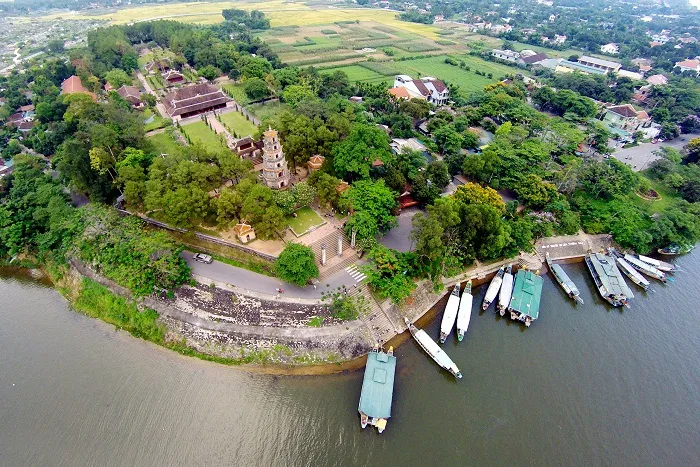
Throughout history, Thien Mu Pagoda has experienced many ups and downs, closely linked to the country’s changes. Under King Tu Duc, the pagoda was renamed “Linh Mu” in the hope of praying for a son, reflecting the king’s desire for an heir. By the time of King Thanh Thai, the name “Thien Mu” was restored and has been used to this day.
When visiting Thien Mu Pagoda, visitors will feel the intersection of history and spirituality, between legends and unique architectural imprints. The pagoda is not only a sacred place of worship but also an inseparable part of Hue’s culture and history.
Unique and Harmonious Architecture of Thien Mu Pagoda: A Blend of Nature and Humanity
The architecture of Thien Mu Pagoda is one of the key factors creating the pagoda’s special attraction. When visiting Thien Mu Pagoda, visitors will be amazed by the harmonious beauty between ancient architecture and poetic natural scenery. The pagoda is built on a high ground, leaning against Ha Khe hill, facing the Perfume River, creating a beautiful feng shui position.
The architectural complex of Thien Mu Pagoda includes many different structures, meticulously and delicately arranged and built, following traditional Buddhist architectural principles. Typical structures of the pagoda include:
- Tam Quan Gate: The main gate leading into the pagoda, built in a two-story, eight-roof style, with three entrances symbolizing the Three Jewels (Buddha – Dharma – Sangha). The Tam Quan Gate is not only an entrance but also a majestic architectural work, showing the solemnity and grandeur of the pagoda.
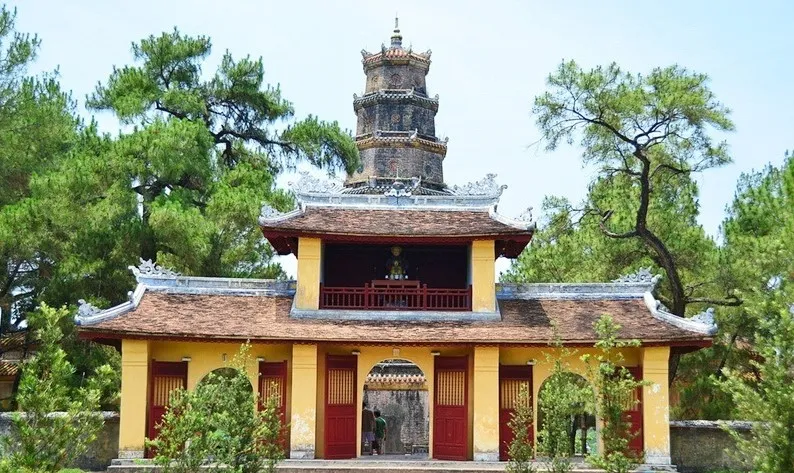
- Phuoc Duyen Tower: Considered the symbol of Thien Mu Pagoda and Hue city, Phuoc Duyen Tower is a unique and impressive architectural work. The tower was built in 1844, is octagonal in shape, 21 meters high, and consists of 7 floors. Each floor of the tower worships a different Buddha, symbolizing enlightenment and liberation. When visiting Thien Mu Pagoda, visitors cannot miss admiring the ancient and majestic beauty of Phuoc Duyen Tower, while learning about the deep spiritual meaning of this structure.
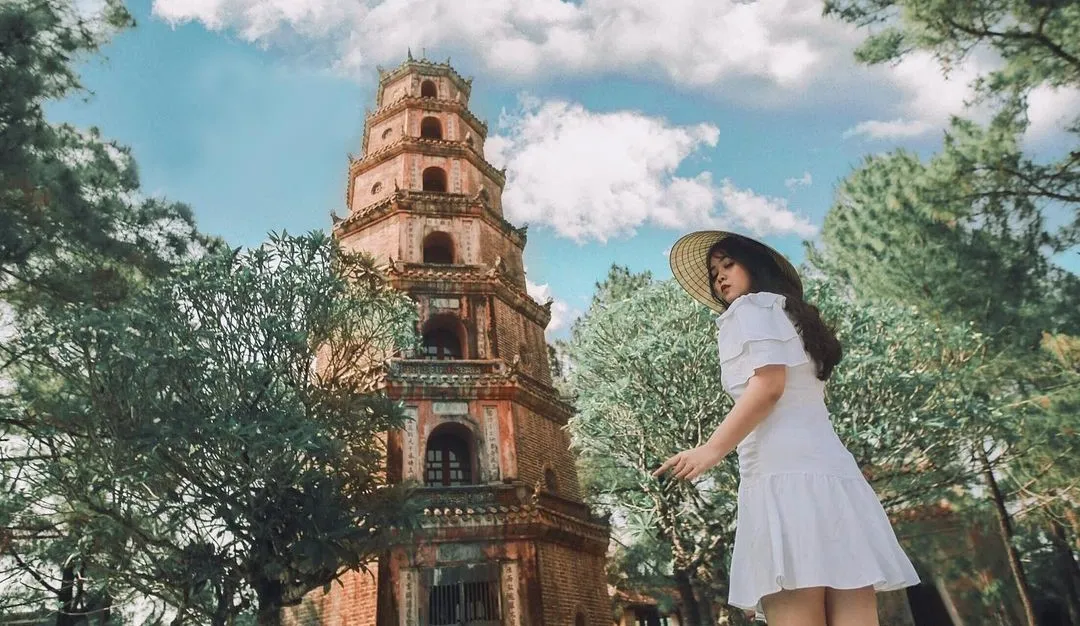
- Dai Hung Main Hall: The main điện (hall) of Thien Mu Pagoda, where Buddha Di Lặc (Maitreya Buddha) and Bodhisattvas are worshiped. Dai Hung Main Hall is built in the trùng thiềm điệp ốc architectural style, with curved roofs and intricately carved columns and beams. Inside the điện, the solemn and tranquil space creates a sense of serenity for visitors visiting Thien Mu Pagoda and praying.
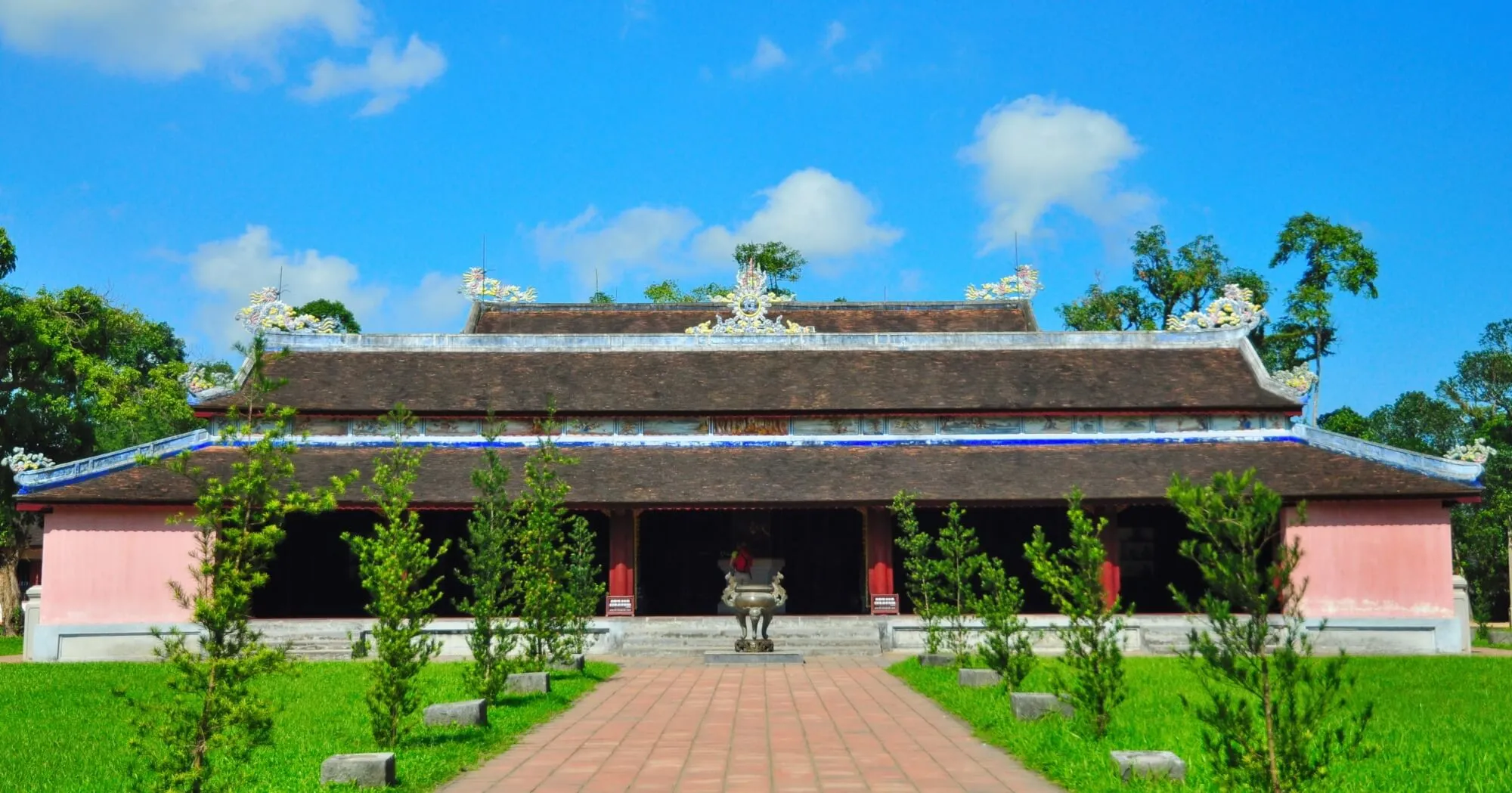
In addition, within the grounds of Thien Mu Pagoda, there are many other architectural structures such as Quan Am Điện (Avalokiteśvara Hall), Dia Tang Điện (Ksitigarbha Hall), the Dharma Talk House, and the Monks’ Residence… Each structure has its own beauty, contributing to creating a harmonious and unique architectural complex.
Exploring Spiritual and Historical Sites When Visiting Thien Mu Pagoda
When visiting Thien Mu Pagoda, visitors not only admire the unique architecture but also have the opportunity to explore the spiritual and historical sites hidden within the pagoda grounds. Each location carries its own story and meaning, enriching the experience of visiting Thien Mu Pagoda for visitors.
- Arhat Garden: Located behind the Dai Hung Main Hall, the Arhat Garden is a tranquil and peaceful space, where 32 Arhat statues are placed, exquisitely carved. Each statue has a different posture and expression, showing the diversity and richness of the Buddhist spiritual world.
- Exhibition Area of Thich Quang Duc’s Car: One of the special and historically significant destinations at Thien Mu Pagoda is the exhibition area displaying the car that carried Venerable Thich Quang Duc. The car is a historical relic of the event of Venerable Thich Quang Duc self-immolating to protest against the policy of religious persecution in 1963. When visiting Thien Mu Pagoda and admiring this car, visitors will feel the patriotism and courage of Venerable Thich Quang Duc, as well as the historical upheavals of Vietnamese Buddhism.
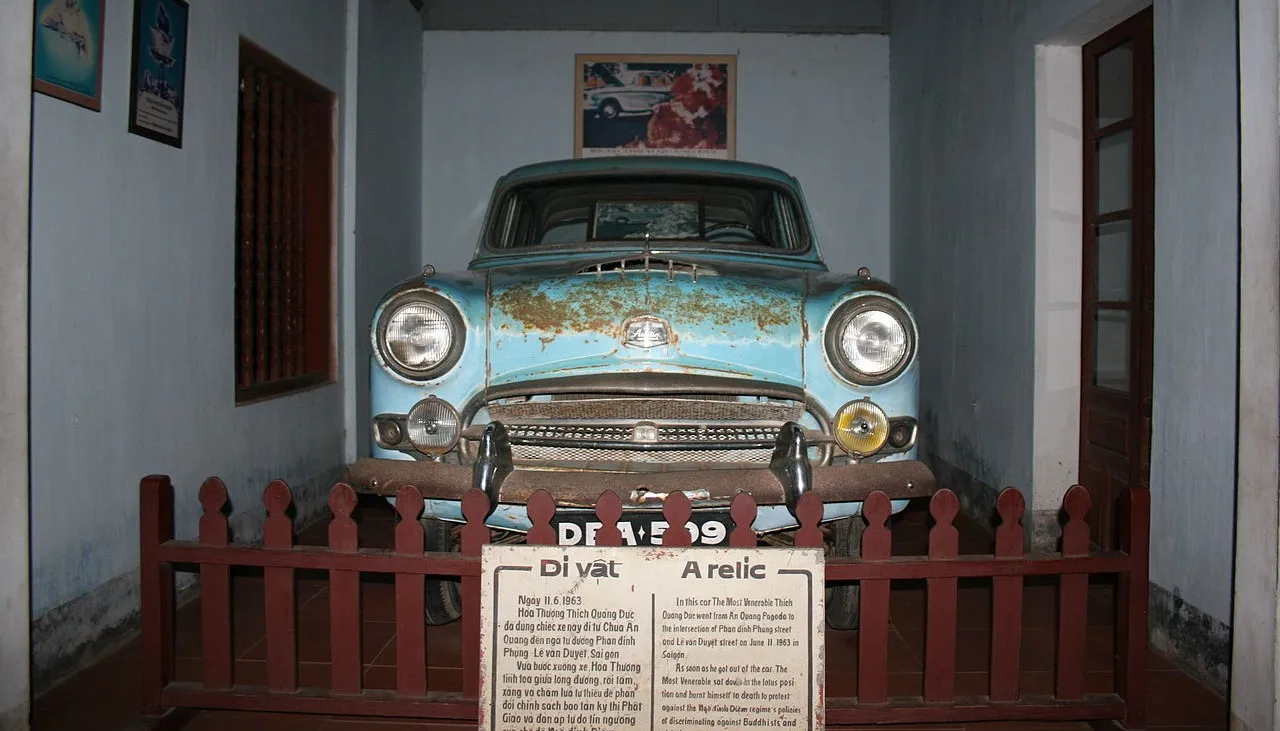
- Tomb Tower of Venerable Thich Don Hau: Located at the end of the pagoda grounds, the tomb tower of Venerable Thich Don Hau is a solemn and peaceful architectural work. Venerable Thich Don Hau was a high-ranking monk who made many contributions to Vietnamese Buddhism and Thien Mu Pagoda. Visiting Thien Mu Pagoda and paying respects at his tomb tower is a way to express reverence and gratitude for the great contributions of this respected monk.
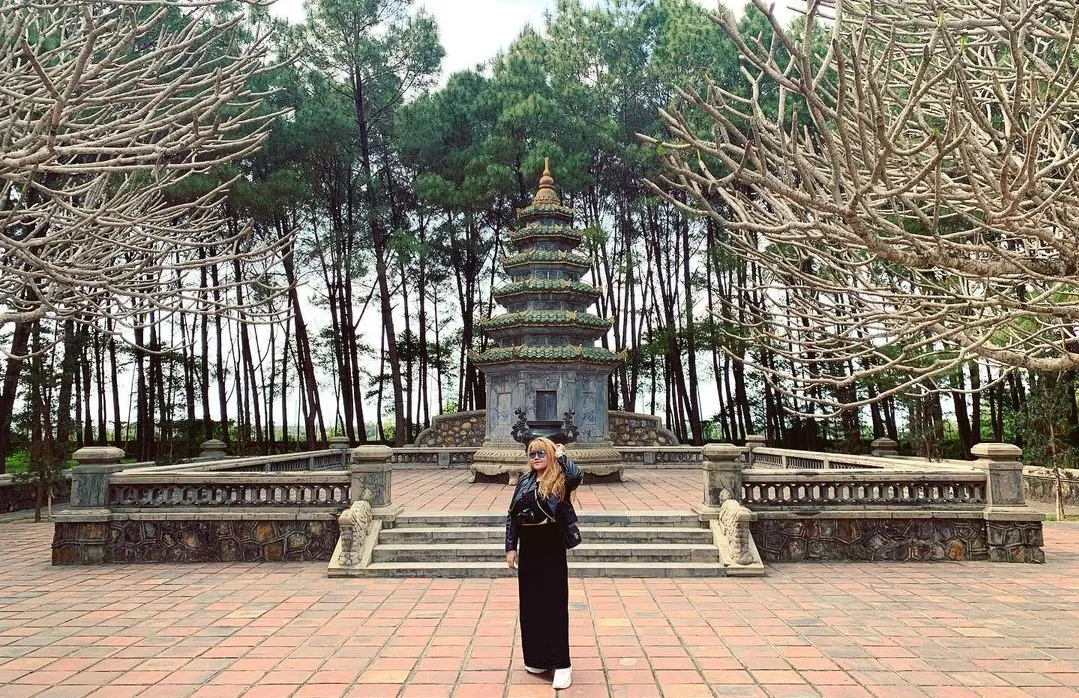
Tips for Visiting Thien Mu Pagoda: A Complete Spiritual Pilgrimage
To have a complete and meaningful visit to Thien Mu Pagoda, visitors should note some of the following tips:
- Ideal time to visit: The best weather in Hue is in spring (January – February) and autumn (September – November). This is the most suitable time to visit Thien Mu Pagoda and explore other tourist attractions in Hue.
- Dress code: When visiting Thien Mu Pagoda and other religious sites, visitors should choose polite and discreet clothing, showing respect for the sacred space.
- Transportation: Thien Mu Pagoda is about 5km from the city center of Hue, visitors can travel by motorbike, car, taxi, or cyclo. Another interesting experience is to take a boat trip on the Perfume River to Thien Mu Pagoda, both to admire the picturesque river scenery and to visit Thien Mu Pagoda in a unique way.
- Other notes: Maintain general hygiene, do not make noise, or use vulgar language within the pagoda grounds. You should bring drinking water and hats if visiting Thien Mu Pagoda in the summer.
Visiting Thien Mu Pagoda is not only a tourist journey but also a profound spiritual experience, helping visitors find a place of peace and tranquility, and explore the unique cultural and historical values of Hue. If you are planning a trip to Hue, do not forget to spend time visiting Thien Mu Pagoda to feel the ancient and sacred beauty of this iconic pagoda.